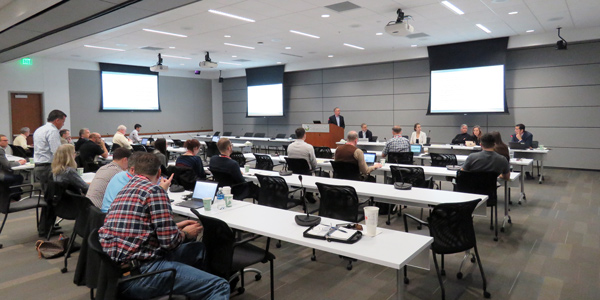By Jason Fordney
FOLSOM, Calif. — CAISO is moving ahead with major modifications to its congestion revenue rights (CRR) auction even as some stakeholders urge a deeper look into the possible detrimental effects of the plan before it goes to FERC.
CAISO defended its approach during a Tuesday forum on the CRR process. Some commenters are saying the ISO is taking an overly simplistic view of the issue: whether the CRR auction is a legitimate hedging mechanism or a process that forces ratepayers to become unwilling participants in losing transactions.
CAISO’s Department of Market Monitoring has become increasingly outspoken about what it calls auction “payment deficiencies” of more than $500 million — the difference between auction proceeds and payouts, which are based on day-ahead market congestion. But some market participants are protesting that the ISO is ignoring other benefits from the transactions. The debate over financial transmission rights is also occurring in other ISOs and RTOs. (See Market Monitors Bring FTR Complaints to Congress.)
CAISO discussed reforms throughout last year and unveiled its initial reform proposal at the beginning of this month. (See CAISO Overhauling CRR Auctions.)
The ISO intends to eventually restrict CRR transactions to only those needed for physical transfer of energy, and limit CRR source and sink pairs to nodes between generators and interties, as well as between trading hubs, loads and interties. It has also proposed to decrease the amount of system capacity released in the CRR auction process from 60% to 40% in the long-term allocation, and 75% to 45% for the annual allocation and auction process — a move intended to reduce overselling of transmission capacity. The ISO would also eliminate disclosure of certain modeling information and align existing outage reporting rules with the annual CRR process.
Track 1 of the effort consists of measures to be put in place for the 2018 auction process this summer, slated for March approval by the Board of Governors. Track 2 will include more significant changes, targeted for board approval sometime in the middle of the year, CAISO Market Design Manager Brad Cooper said in a presentation.
Kolby Kettler, of energy and commodities trader Vitol, has questioned the proposal since it was introduced. On Tuesday, he said the plan could introduce detrimental effects and new risks that CAISO has not considered.
“Other ISOs have also gone down this avenue, looking at removing locations, and have backtracked” because of revenue loss to the market, he said. He urged CAISO to focus on “fixing the model, and not focus on removing what could be a legitimate hedging activity or valuing congestion.”
“We are working to try and quantify the benefits of auction CRRs to the broader market,” Cooper replied, adding that “this isn’t the net effect … because CRRs have a benefit to the bilateral market.”
Speaking for the Western Power Trading Forum, Ellen Wolfe contended that CAISO was operating from a narrow viewpoint. She said the ISO has “narrowed in on the premise of the purpose of the CRRs being this physical hedge,” but that certain hedges might be beneficial for physical supply in ways the ISO is not considering.
“You build these proposals based on that particular premise — it presents a very narrow viewpoint of the world — and present anything outside of that viewpoint as not legitimate,” she said. “It is at least beneficial … to acknowledge that not everybody agrees with your premise.” Previously, there was never a sense that CRRs should be made available only to generators serving a load, she said.
“We are doing all we can to understand the uses,” Cooper said, but the auction revenues are far short of what CRRs are paying. “Sure, we would be eliminating combinations to allow for every type of conceivable hedging opportunity,” but “I think we are striking a reasonable balance,” he added.
CAISO is taking comment on its CRR proposal through Feb. 28.







